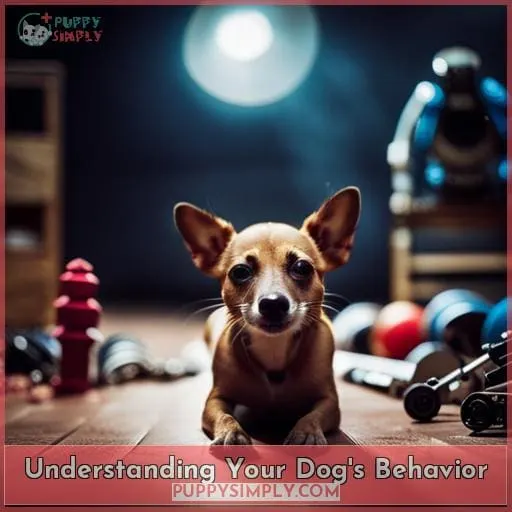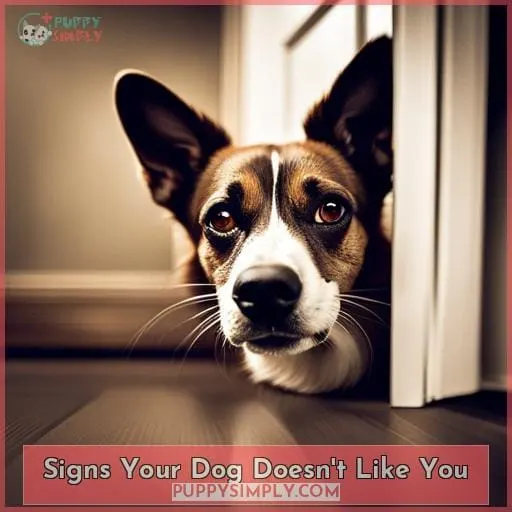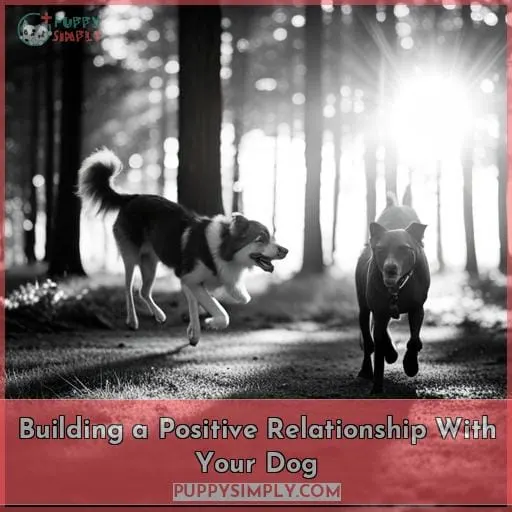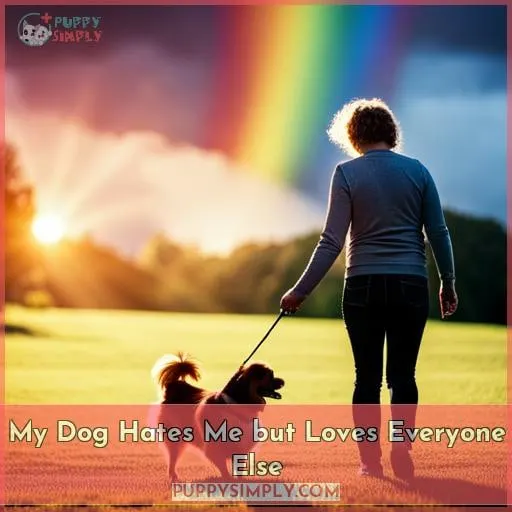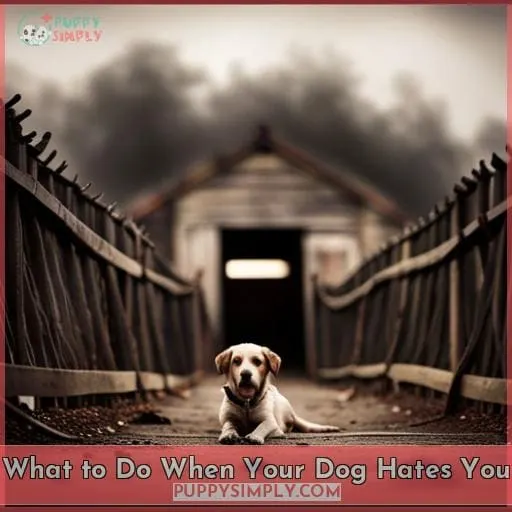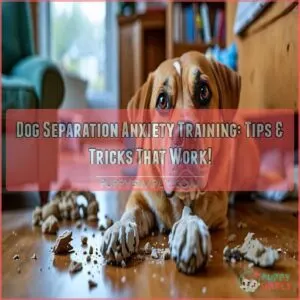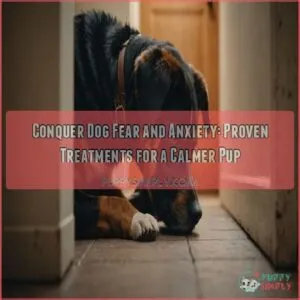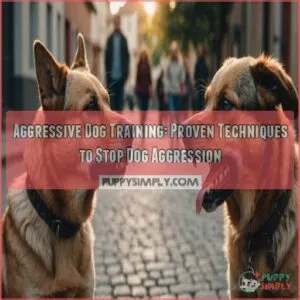This site is supported by our readers. We may earn a commission, at no cost to you, if you purchase through links.
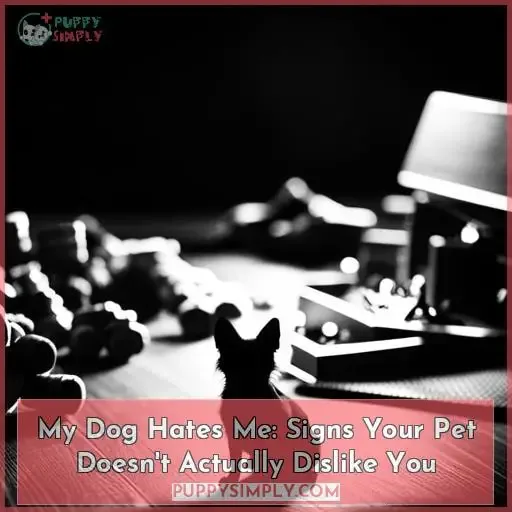
In this article, we’ll explore the various reasons why it might appear as though your beloved four-legged friend isn’t fond of having you around and how to create an amicable relationship between yourself and your canine companion.
Table Of Contents
Key Takeaways
- Observing triggers and offering space can help build trust with a dog who seems distant or dislikes you.
- Understanding the causes of a dog’s dislike, such as past abuse or lack of socialization, can help with patience and building trust.
- Misinterpreting reactions due to a lack of understanding of a dog’s needs can hinder the bonding process. Giving space, using soothing voices, and offering treats can help build trust.
- Providing a dog with their own space and respecting boundaries can help them feel secure and more likely to bond with you.
Understanding Your Dog’s Behavior
Gaining an understanding of your pup’s behavior is key to building a strong bond, so take time to note triggers and look for signs of affection. It may be that your independent breed has been subjected to physical punishment in the past or hasn’t had enough exposure to new people.
Observe their body language carefully – if they seem scared by something like hats, then try allowing them the space and time they need to adjust on their own terms. Food can be used as a trust-builder, offering treats from both hand and floor before slowly decreasing distance as comfort increases over time.
Play can also help you build rapport with them. Walks are great bonding experiences during which you should remain calm but assertive while reinforcing good behaviors without scolding or punishing them.
Signs Your Dog Doesn’t Like You
It’s natural to feel like your dog hates you, but it may not be as simple as that. Your dog may have experienced a traumatic event or had negative experiences in the past that can make him appear to dislike you despite his true feelings.
Lack of understanding of their needs and behavior can also lead humans into believing their dogs hate them when they’re just trying to communicate something different.
It’s important for pet owners to keep an open mind and look for signs beyond what could simply be misinterpreted reactions from their beloved companion animals.
Projecting Feelings of Hate
It’s important to be aware of the subtle signs that your dog may not like you and is projecting feelings of hate. This could include things like keeping a cold shoulder, avoiding family time, or giving you a wide berth when in close quarters.
Dislike can often stem from negative experiences with previous owners or lack of socialization, as well as fear around certain triggers such as stature or voice tone. It’s important to understand the cause before attempting any corrective measures and always take necessary safety precautions for yourself first before trying to help an aggressive dog.
Projecting feelings of hate takes more than just time, but patience and consistency too!
Trauma Can Make Your Dog Seem Like He Hates You
Trauma can cause your beloved pet to appear as if they don’t like you, but with patience and understanding, it’s possible to build a strong bond. Past trauma or traumatic experiences from negative doggy interactions can make your pup seem distant and reserved.
However, there are subtle signs that indicate he does, in fact, still care for you, such as looking up at you for direction or seeking comfort from your presence.
Negative Experiences
Negative experiences, such as abuse or lack of socialization, can lead to a fear-based dislike in your pup. He may express his discomfort through explicit behaviors, such as aggression, or by avoiding contact altogether.
If he’s had a past full of trauma, it’s no wonder why he might not show the same kind of affection towards you that other dogs do.
Be aware though: bad behavior should always be corrected in order for progress to happen.
Lack of Understanding
Understanding your dog’s needs is key to building a strong bond between you. Take note of triggers, such as their reaction to certain items like a cowboy hat or protectiveness. Dogs are emotional creatures, so give them physical space and use soothing voices when communicating with them.
Food can also build trust – offer treats from both your hand and the floor, allowing them to take at their own pace until they become comfortable being near you again.
The way dog owners interact with dogs creates an environment where mutual understanding and respect can be achieved.
Building a Positive Relationship With Your Dog
Gaining the trust of your pup often requires patience, but with time and effort, you can build a positive relationship. To start off on the right paw, give them some space to get comfortable; don’t overwhelm them with too much physical contact or loud noises.
Give Them Time
Give your dog the time and patience it needs to become comfortable with you and develop a strong, positive bond. If you’ve just got a new rescue dog or an independent breed, they may not be used to human interaction yet.
Allowing them a little time physically close to you is important for building trust in that relationship. It takes dedication, but having this great relationship will make all the effort worth it! Remember that spending quality time together, even when playing with toys or going on walks one-on-one, reinforces the connection between both of you.
Give Them Space
Provide your pup with their own physical space, like a bed or crate, to relax and feel comfortable. Studies show that dogs are more likely to bond with owners who respect the pet’s boundaries. Take note of any triggers that may cause fear – it could be anything from one’s stature to their voice.
For an independent shelter dog or working line dog, having personal space is essential for them to feel secure in their environment. It can help build trust between the owner and the animal over time if done correctly.
If you find yourself living in an area where there is always someone present, such as maintenance workers, etc., then setting aside specific areas just for your pup will encourage them to open up emotionally within these safe spaces when they’re ready.
This allows you both time needed away from potential stressors or distractions until they’re at ease around people again.
Give Them Treats
Offer your pup treats to build trust and create a positive association with you. Food is an effective way of doing this, especially for independent or food-motivated rescues. Start by offering them from the floor, then gradually move up towards your hand as they become more comfortable.
Here are five tips to consider when providing treats:
- Reward good behaviors in order to reinforce desired actions.
- Avoid scolding or punishment.
- Introduce new people/dogs slowly while socializing properly.
- Be consistent with routine so dogs can anticipate what comes next.
- Hand-feed the dog for independent or food-motivated breeds in order to strengthen the bond between pet and human.
With patience, consistency, understanding, love, and some delicious snacks, your pup will learn how to grow closer with you over time!
My Dog Hates Me but Loves Everyone Else
It’s understandable that you feel frustrated when your pup shows more affection to others than yourself; however, it may just take a bit of extra time and patience on your part for the two of you to develop a strong bond.
Dogs can be unpredictable and react differently depending on their past experiences.
Spending quality time with them is one way to get through this barrier and start building up trust between you two.
Additionally, socializing with other dogs is essential for a pet’s development since different breeds respond in different ways – some need less interaction while others crave attention from multiple sources.
Different mileage, so make sure not only are you spending enough time with them but also providing an environment where there are plenty of opportunities for new experiences without overwhelming stressors present.
Understanding how each individual dog’s heart works helps create meaningful connections between owners and pets alike, resulting in mutual respect no matter what kind of relationship was established at first sight.
What to Do When Your Dog Hates You
If you feel your pup is treating you differently than others, there are steps you can take to strengthen the bond. A pet’s dislike of a particular person may not be that person’s fault, and dogs are capable of second chances.
It could stem from past abuse or lack of socialization, so it’s best to determine the cause first before taking any action.
Signs such as physical aggression should be addressed by professional help immediately for safety reasons.
For fearful dogs who show no signs of aggression, try building trust through food rewards and toys. Offer treats from either hand or floor, then let them take it themselves when they’re comfortable enough.
Avoid scolding as negative reinforcement will only worsen their behavior. Instead, focus on reinforcing good behaviors whenever possible while paying attention closely for subtle signs like eye contact, which indicate interest in being near you.
Lastly, create consistency by setting up routines such as providing its own space like bedding where respect boundaries must always be met, regardless if friends come over or not.
Do Some Dogs Dislike Their Owners?
Though it may be hard to believe, some dogs can develop a dislike of their owners. This is usually because the pet has experienced something that makes them wary or uncomfortable around their owner, such as a new person in the house, an owner’s large stature, or simply because they’ve been exposed to different people and environments over time.
But despite this pet’s dislike for its owner, dogs have an amazing capacity for forgiveness and love—if given enough time and patience from their human counterpart.
When your dog doesn’t like you, it can be heartbreaking, but there are things you can do to try and build trust with your furry companion again:
- Offer treats from hand or floor.
- Use playtime activities such as toys.
- Go on walks together.
- Show affection by cuddling when possible.
- Provide a consistent routine throughout the day.
- Respect boundaries.
- Get professional help if necessary.
- Introduce slowly to other people/dogs.
- Avoid scolding and punishment.
- Be patient and persistent during the bonding process.
No matter how distant our relationship might feel at times with our pets due to any incidents related to our own behavior towards them, we must remember that all animals deserve respect regardless of whether they reciprocate those feelings back yet.
Frequently Asked Questions (FAQs)
How do I know if my dog is scared of me?
Signs that your dog may be scared of you include avoiding eye contact, cowering away from you, refusing treats and food near you, rapidly panting, or tucking their tail between their legs. Pay close attention to body language; fearful dogs often exhibit a tense posture with ears back and head lowered.
If they feel threatened by your presence, they will likely display signs of aggression such as growling or snapping at you.
What can I do to help a dog who has had a bad experience in the past?
Investigate the cause of past bad experiences and offer a safe space for your dog to adjust. Use treats to build trust, play with toys for bonding, and reassure with a calm voice.
How do I get my dog to trust me?
Gently build trust with your pup, step by step. Start with small treats and toys – create positive associations.
How can I tell if my dog is showing signs of affection?
Look for subtle signs of affection, such as looking to you for direction, seeking comfort from you, preferring you over others, following you around the house, cuddling with you on the couch, and wanting pets.
If these behaviors are present, then your dog is likely showing signs of affection towards you.
How do I properly socialize my dog?
Socialize your pup by gradually introducing them to new people and dogs. Show patience, respect their boundaries, and give them time to adjust.
Conclusion
At the end of the day, it’s hard to tell if your canine friend actually hates you or not. With a little patience, understanding, and compassion, however, you can build a positive relationship with your pup.
It may take time and effort to repair the bond if there have been negative experiences in the past, but it’s possible. Dogs are emotional creatures and they need to be shown love and care. If your dog hates you, don’t be too hard on yourself.
Just take it one day at a time and trust that your pup will come to understand and love you for who you are. After all, there’s no greater feeling than having your dog look at you with love and admiration in their eyes.

